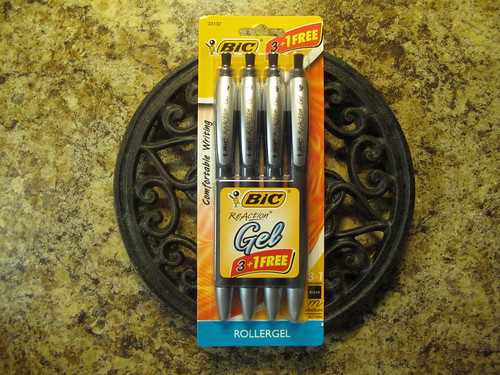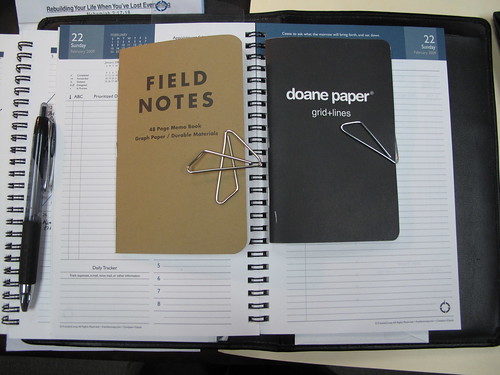The town where I live (Prattville, Alabama) has an abundance of antique and thrift stores. Some might say an excess number. The distinction tends to blur as one might find some nice antiques in one of the thrift stores and some pretty tacky junk in the antique stores. On occasion, I like to make the rounds in hope of finding some nice, vintage writing tools - fountain pens, pen holders, blotters or even an old manual typewriter.
I was off on Thursday, so I decided to check out three spots I frequent - the Old Courthouse Antique Store, the Goodwill Store, and a "giant flea market" that's located in an old grocery store.
Our local Goodwill Store is somewhat small, and their stock of items other than clothes was slim. They had some interesting small kitchen appliances that looked like they came from a mad scientist's laboratory, but no writing implements. Not that I really expected such at Goodwill, but they have been known to receive the odd typewriter. No luck this week.
The Old Courthouse Antique Store is an interesting place in itself. It actually was the Autauga County Courthouse from 1870 until the 1920s when the "new" courthouse was built one block up Court Street. It even has a historical marker in front.

Entering the tall, white brick edifice you're greeted by a nice lady at the front desk. She smiles and tells you to "make yourself at home," which I do. The old heart-pine floorboards creak, but the building is in very good condition. Glass cabinets, racks of shelves and stacks of eclectic items lead you into a maze of the old, the forgotten, the unwanted and the occasional treasure. I spent a pleasant hour wandering through - no writing instruments, alas, though the proprieter said she had some fountain pens last month . . . or was it last year? I found an interesting toy typewriter, still in its original box, but it was of a more recent vintage and made of plastic. Pass. The nice lady said her husband was bringing in a portable typewriter. Manual? I asked. Yes. Does it have a case? Yes. She wasn't sure of the brand, but I can swing back by on a lunch break next week. (The Old Courthouse is only two blocks from the church where I serve.) I did find a nice, olive-green canvas satchel with numerous pockets. It will make a nice camera bag with some added padding. Three dollars poorer, and with satchel in tow, I headed to the flea market.
The Old Court House Antique Store is fairly large. The flea market, by comparison, is huge. As I progressed through the hap-hazard aisles, I wished that I had brought bread crumbs to drop along the way, or at least a compass. The flea market is a wonderful conglomeration of odds and ends - most of it odd. It's easy to experience a degree of sensory overload in such a place. Moldering old books share space with baby furniture. Carpet remnants lean against old outboard motors. Glass cases of baseball cards, cheap pocket knives and old vinyl LP albums are surrounded by the rotting carcasses of old computers and grimy printers. In the middle of the flea market, I was surprised to find a barber shop! "Doc," the barber in residence was not to be found (perhaps he got lost), but I was quite impressed by the ancient barber chair that took center-stage in his eight-by-eight cubicle. I expected to see a sign proclaiming, "shave and a hair-cut: two bits." Instead, there was a hand-written sign advertising $10 haircuts. Again, pass.
Unfortunately, I had no luck with fountain pens. The twenty-something young woman who was at the check out apparently had never heard of such a thing. I did find five typewriters - mostly recent vintage Brother electrics that looked like they had been buried in a field for several decades, though they couldn't have been more than ten to twenty years old. There was also one decent Smith-Corona electric, but it held no interest for me. It was, however, sitting on a very nice, metal typewriter stand that caught my eye. $10 was a reasonable price, but good sense prevailed and I moved on. I just don't really have room for a typewriter stand. At least, that's what my wife says. Still, if it's there when I return . . .
All in all, I spent a pleasant few hours digging through the detritus of other people's past. To be honest, I sometimes shook my head in puzzlement and bemusement over the vast array of tacky items I encountered - black velvet paintings of matadors (no Elvis paintings this trip), cheap Ninja swords, faded plastic flowers and faux-leather jackets. Yet, there were some genuine antiques in the midst - nice, sturdy furniture of a by-gone era, old hard-cover books, green depression glass-ware, coffee grinders, even an old leather football helmet like the Gipper wore. No pens, no pen-holders, no blotters . . .
this time. But who knows when I'll find that old Esterbrook or Parker 51 or maybe that Smith-Corona Silent Super, just waiting for me to take it home and make it useful again?
I'll be back to continue my quest. (Cue "Indiana Jones" theme music)

Odds & Ends (Mostly Odds)












